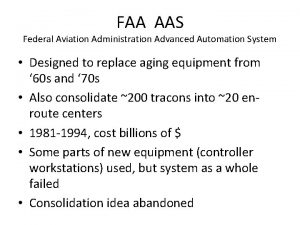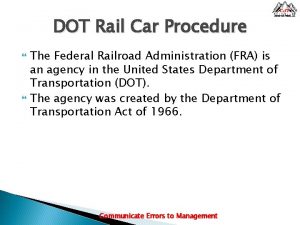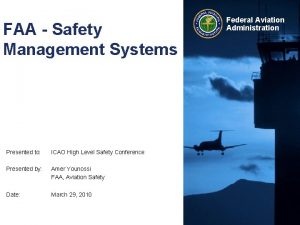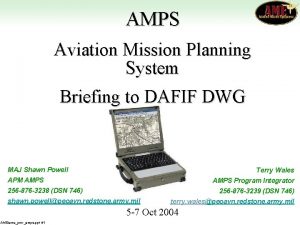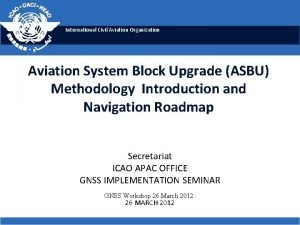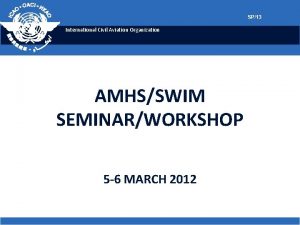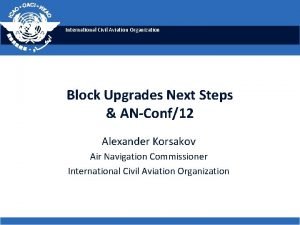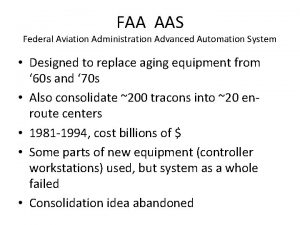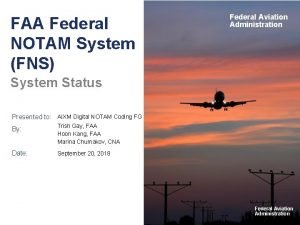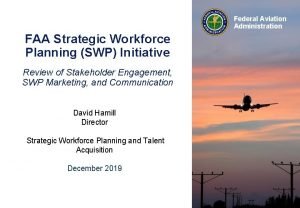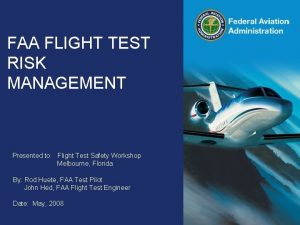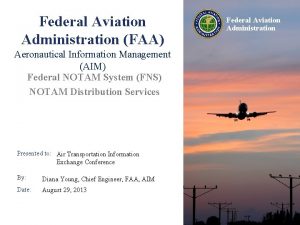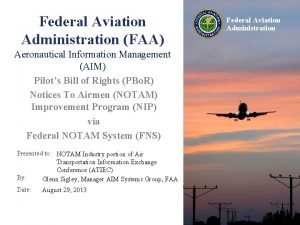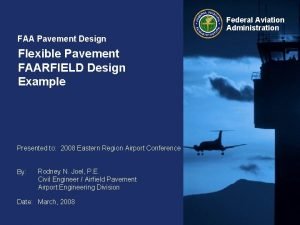FAA AAS Federal Aviation Administration Advanced Automation System










- Slides: 10

FAA AAS Federal Aviation Administration Advanced Automation System • Designed to replace aging equipment from ‘ 60 s and ‘ 70 s • Also consolidate ~200 tracons into ~20 enroute centers • 1981 -1994, cost billions of $ • Some parts of new equipment (controller workstations) used, but system as a whole failed • Consolidation idea abandoned

FAA AAS Requirements • • • Distributed system 99. 99999% availability (3 sec/year downtime) No paper (electronic flight slips) New hardware New software and decision support

FAA AAS Problems • Design contest IBM vs. Hughes – 1983 to 1988 – Detailed design of software but no coding – Voluminous documentation • Implementation by IBM – Many levels of bureaucratic oversight by FAA – Changing requirements, but not what controllers wanted

FAA AAS Alternatives • Modern display system + tracking software at High Desert Tracon – Needed to track fast military aircraft – Separate project funded by Do. D – Open system, COTS equipment (Sun), evolutionary progress of components • PC-based display developed in secret by FAA engineers

FBI VCF Federal Bureau of Investigations Virtual Case file • 9/11 – FBI failed to “connect the dots” and obtain a full picture – Agents could not correlate data from different sources and investigations – Work processes are paper-based • Need to replace obsolete Automated Case Support system – And consolidate many other databases and applications • Actually started in 2000, accelerated after 9/11 • Cancelled in Apr 2005 after costing $170 M

FBI VCF Plan • Replace essentially all diverse FBI IT infrastructure • 800 -page requirement document – Specifies design details like web-page layouts rather than what the system should do • Aggressive deadlines but no milestones or detailed schedule • Use a “flash cutover” – log off old system on Friday and into new system on Monday

FBI VCF Problems • Lack of overall encompassing architecture • Many change requests once agents saw prototypes (using spiral model) • Resulting schedule slips

FBI VCF Replacement: Sentinel • 6 years development, ~$440 M • In operation since July 2012 • Success credited to shift from waterfall to agile in 2010 • Also use significant off-the-shelf products

USCIS ELIS US Citizenship and Immigration Services Electronic Immigration System • 8 M applications a year, all paper, requiring sending forms between offices • Plan: computerize 95 forms and pay 40 fees online by 2013, cost of 500 M$ • 2015 status: 1 form and 1 fee are working, cost 1. 7 B$ – Application to renew or replace lost green card – 2 other forms were pulled due to problems • Projected completion 2019, cost 3. 5 B$

USCIS ELIS Problems • 2008 contract to IBM using waterfall • Requirements complete only in 2011 • Takes up to 150 clicks to review an application – Navigate menus, open documents, etc. – Test: complete 0. 86 cases/hour, compared with 2. 16 with paper forms • Integration of 29 commercial software products • 2013: switch to multiple vendors, more agile – But 4 -month work cycle • 2015: switch to cloud platform
 Faa advanced automation system failure
Faa advanced automation system failure Rsoo
Rsoo Fha new deal relief recovery reform
Fha new deal relief recovery reform Federal railroad administration train car
Federal railroad administration train car Advanced automation functions
Advanced automation functions Safety management system faa
Safety management system faa Aviation mission planning software
Aviation mission planning software Aviation system block upgrades asbu
Aviation system block upgrades asbu Amhs aviation
Amhs aviation Aviation system block upgrades
Aviation system block upgrades Aviation system block upgrades
Aviation system block upgrades
